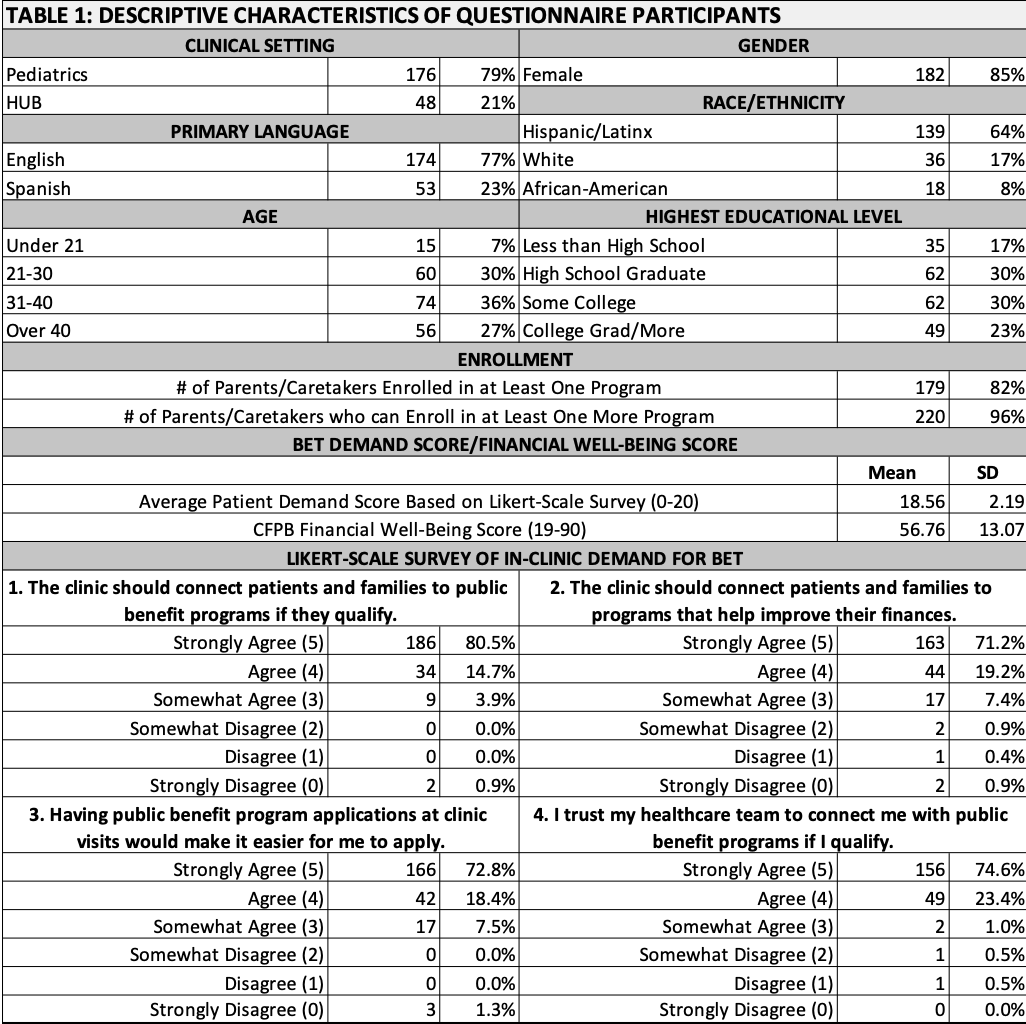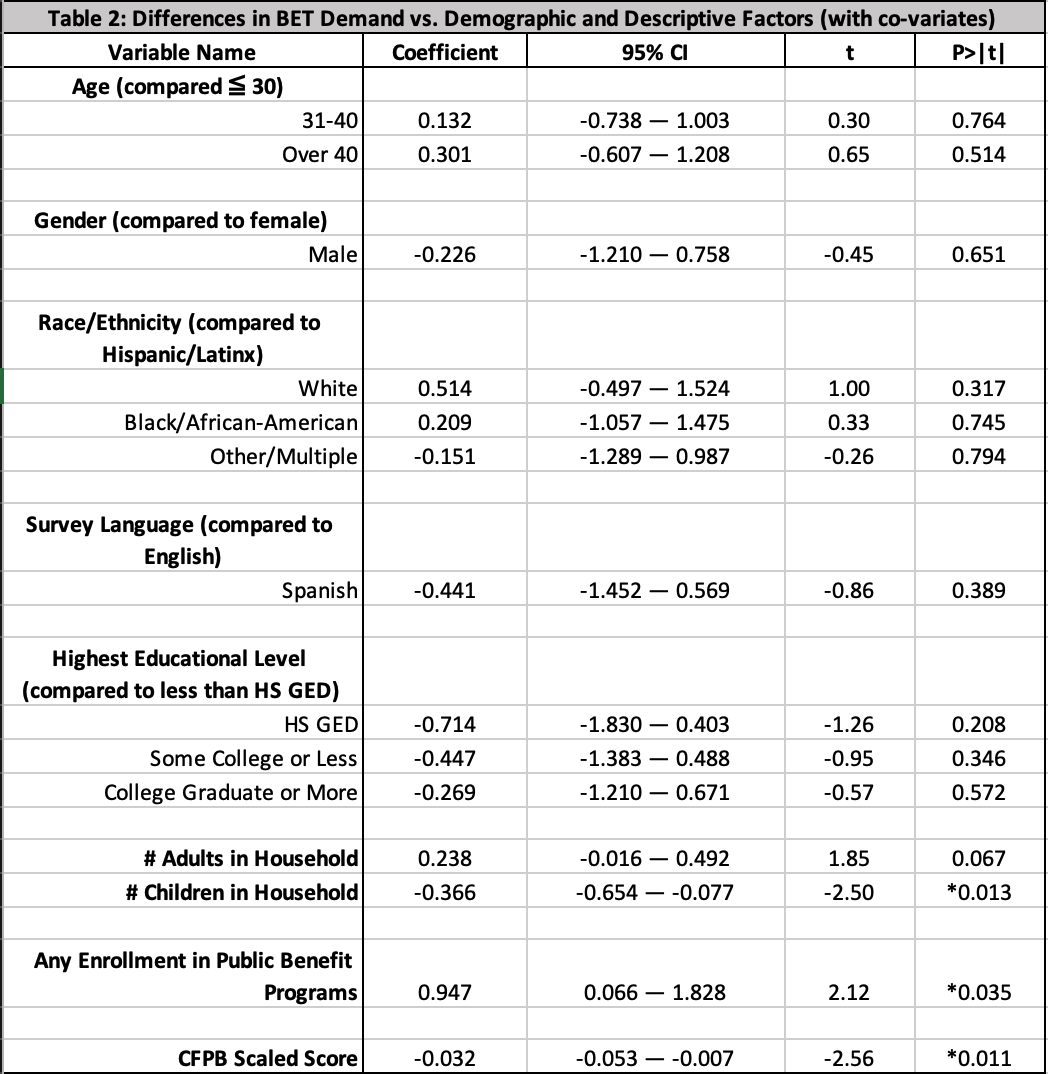Health Services Research
Category: Abstract Submission
Health Services Research I
189 - Association of Benefits Explorer Tool Demand Score with Demographic and Descriptive Factors at a Los Angeles Pediatric Safety Net Clinic
Sunday, April 24, 2022
3:30 PM - 6:00 PM US MT
Poster Number: 189
Publication Number: 189.319
Publication Number: 189.319
Colin G. Wang, University of California, Los Angeles David Geffen School of Medicine, Los Angeles, CA, United States; Patrick Liu, UCLA, Los Angeles, CA, United States; Monique Holguin, University of California, Los Angeles David Geffen School of Medicine, South Pasadena, CA, United States; Adam Schickedanz, UCLA, Los Angeles, CA, United States
.jpg)
Colin G. Wang
Medical Student
University of California, Los Angeles David Geffen School of Medicine
Los Angeles, California, United States
Presenting Author(s)
Background: Financial stress predicts worse health outcomes, particularly in childhood. Public anti-poverty programs buffer financial stress but have barriers to access. Health systems serving patients eligible for public benefits are increasingly addressing financial stress directly.
Objective: We assessed patient/family demand for a QR code-accessible web portal (Benefits Explorer Tool, BET) for public anti-poverty program applications for food (CalFRESH/SNAP, Free and Reduced School Lunch, WIC), utilities (CARE/FERA), phone and high-speed internet (Lifeline) resources at an academically-affiliated safety net clinic.
Design/Methods: Through convenience sampling, we surveyed adult caregivers of Medi-Cal insured/eligible patients at Olive View-UCLA primary pediatrics clinic regarding their degree of agreement (5-point Likert scale, 5 = strongly agree; Table 1) with four statements regarding in-clinic connections to public benefits program applications, as well as current enrollment and interest in enrollment in each of the public benefits programs the BET included. All families/children were eligible for these public benefits programs by virtue of their Medi-Cal eligibility. A summary BET program “Demand Score” was constructed as the sum of Likert scale responses to the four public benefit interest statements. We also collected information on financial stress/well-being (Consumer Financial Protection Bureau Financial Well-Being Scale, CFPB-FWBS) and sociodemographics. Associations between sociodemographics or CFPB-FWBS and BET program enrollment/interest were measured using multivariate regression.
Results: Of 226 participants, 84% were enrolled in at least one of the programs with an average enrollment of 1.86 programs and 97.4% had at least one or more programs they could enroll in. Over 90% of participants agreed that the clinic should connect patients to public benefits, can improve their finances, that such an approach would reduce enrollment barriers, and they trust their health care team with these roles. BET Demand Score had an average of 18.56 (2.188, range 8-20) (Table 1). Mean CFPB-FWBS (range 19-90) was 56.76 (SD 13.07). Enrollment in any program, lower financial well-being score, and decreased number of children significantly correlated with higher BET Demand Score (Table 2).Conclusion(s): Our study of Medi-Cal eligible families demonstrates high demand for anti-poverty program enrollment tools like the BET, with little variation across patient/parent sub-groups. Clinic-based technology solutions may help address upstream financial determinants of health.
Table 1: Descriptive Characteristics of Questionnaire Participants
Table 2: Differences in BET Demand vs. Demographic and Descriptive Factors
Objective: We assessed patient/family demand for a QR code-accessible web portal (Benefits Explorer Tool, BET) for public anti-poverty program applications for food (CalFRESH/SNAP, Free and Reduced School Lunch, WIC), utilities (CARE/FERA), phone and high-speed internet (Lifeline) resources at an academically-affiliated safety net clinic.
Design/Methods: Through convenience sampling, we surveyed adult caregivers of Medi-Cal insured/eligible patients at Olive View-UCLA primary pediatrics clinic regarding their degree of agreement (5-point Likert scale, 5 = strongly agree; Table 1) with four statements regarding in-clinic connections to public benefits program applications, as well as current enrollment and interest in enrollment in each of the public benefits programs the BET included. All families/children were eligible for these public benefits programs by virtue of their Medi-Cal eligibility. A summary BET program “Demand Score” was constructed as the sum of Likert scale responses to the four public benefit interest statements. We also collected information on financial stress/well-being (Consumer Financial Protection Bureau Financial Well-Being Scale, CFPB-FWBS) and sociodemographics. Associations between sociodemographics or CFPB-FWBS and BET program enrollment/interest were measured using multivariate regression.
Results: Of 226 participants, 84% were enrolled in at least one of the programs with an average enrollment of 1.86 programs and 97.4% had at least one or more programs they could enroll in. Over 90% of participants agreed that the clinic should connect patients to public benefits, can improve their finances, that such an approach would reduce enrollment barriers, and they trust their health care team with these roles. BET Demand Score had an average of 18.56 (2.188, range 8-20) (Table 1). Mean CFPB-FWBS (range 19-90) was 56.76 (SD 13.07). Enrollment in any program, lower financial well-being score, and decreased number of children significantly correlated with higher BET Demand Score (Table 2).Conclusion(s): Our study of Medi-Cal eligible families demonstrates high demand for anti-poverty program enrollment tools like the BET, with little variation across patient/parent sub-groups. Clinic-based technology solutions may help address upstream financial determinants of health.
Table 1: Descriptive Characteristics of Questionnaire Participants

Table 2: Differences in BET Demand vs. Demographic and Descriptive Factors

